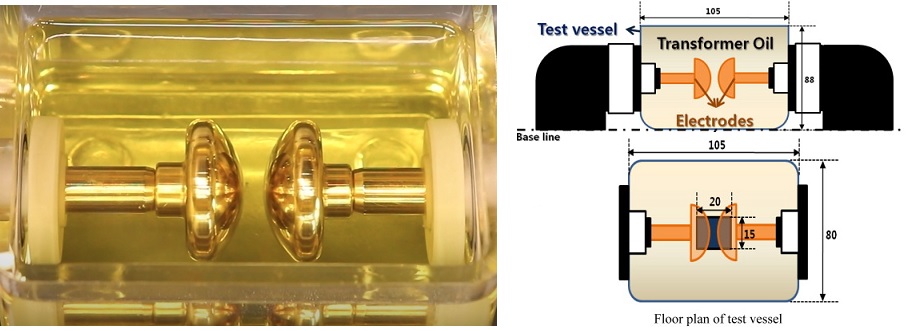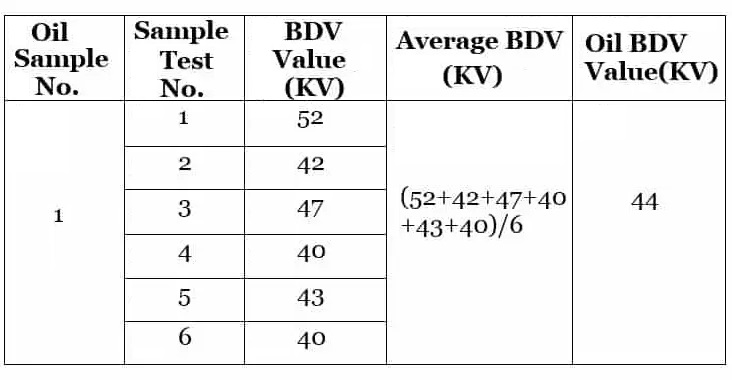 JY6611 Insulating oil breakdown voltage tester adopts completely new electromagnetic compatibility concept(EMC) which designed to avoid tester crash accident during testing, and also can still work well in high magnetic field.
JY6611 Insulating oil breakdown voltage tester adopts completely new electromagnetic compatibility concept(EMC) which designed to avoid tester crash accident during testing, and also can still work well in high magnetic field.
JY6611 also use advanced voltage breakdown control technology which will keep breakdown energy in a very low level, that will avoid pollution to oil sample during testing and make sure the test result are accurate and reliable.
The unique advantage of this tester lies in the built-in electronic boost system, the voltage regulation power supply adopts an electronic inverter sine wave generator, the voltage output is accurate, the waveform quality is high, and it is not affected by the grid voltage fluctuation and waveform distortion, making the test data more accurate and efficient. . The built-in advanced insulating material and heat dissipation system make the built-in step-up transformer stable and reliable, which can make the tester withstand long-term high-voltage breakdown tests, protect the safety of operators, and prolong the service life of the tester.
JY6611 oil cup is made by new material with high strength and long service life to avoid fragile and leakage problem during testing.

4. Complete protection system:
JY6611 has a variety of protection devices which will make sure the safety of operator and tester itself in accident like inferior oil breakdown voltage and empty cup breakdown.
5. Multiple international testing standards
Fully automatic test sequences for 12 common test standards around the world and spot tests(Standard: ASTM D877 & ASTM D1816, IEC 60156)
6. International universal stainless steel calipers
Precise adjustment of standard electrode distances
7. Overall shielding technology
Perfect overall shielding technology can prevent all sources of electronic interference to ensure a pure test environment
8. Provide multilingual technical instructions
Provide English operation page and operation instructions in 15 languages


TECHNOLOGY SPECIFICATION:
|
Type |
JY6611 oil break down voltage(BDV) tester |
|
Output voltage |
0~80kV/100kV |
|
Minimum resolution |
0.1kV |
|
Accuracy |
±2%*Reading±0.2kV |
|
Voltage raise speed |
1 .0/2.0/3 .0kV/s for option |
|
Switch-Off time on breakdown, ms |
≤1ms |
|
Experimental times |
1~6 for option |
|
Programmed test standard |
IEC60156/ASTM D877/ASTM D1816/VDE0370 |
|
Memory for result |
30 group |
|
Volume of the oil cup |
400ml & 200ml |
|
Gap between the poles |
2.5 mm (Electrode gap is adjustable) |
|
Temperature in operation |
0~40℃ |
|
Relative humidity |
≤80%RH, No forming dew |
|
Power supply in operation |
AC220V±10%, 50Hz±1% |
|
Volume / Weight |
Length 385 mm Width 300 mm Height 360 mm / 22kgs |
8. If insulating oil BDV value is above 30 KV, transformer oil is good.


When a voltage is applied to the insulating oil, as the voltage increases, the current through the oil increases sharply, causing it to completely lose its inherent insulating properties and become a conductor. This phenomenon is called breakdown of the insulating oil. The critical voltage value at which the insulating oil breaks down is called the breakdown voltage or dielectric breakdown. The electric field strength at this time, called the dielectric strength of the oil, indicates the ability of the insulating oil to resist the electric field. The relationship between the breakdown voltage U (kV) and the dielectric strength E (kV/cm) is: E=U/d"
d"=The distance between the electrodes (cm).

Pure insulating oils have different breakdown mechanisms than insulating oils, which usually contain impurities.
The breakdown of the former is caused by the liberation, which can be explained by the mechanism of gas dielectric breakdown, that is, under high electric field strength, oil molecules collide and become free ions and electrons, thereby forming electron collapse. The electron collapses toward the anode, and the accumulated positive charge collects near the cathode, eventually forming a channel with high conductance, resulting in breakdown of the insulating oil.
Generally, insulating oils always contain more or less impurities, and in this case, impurities are the main cause of breakdown of insulating oil. The dielectric coefficient ε of water droplets, fibers and other mechanical impurities in oil is much larger than that of oil (ε=7 of fiber, ε=80 of water, and ε≈2.3 of transformer oil), so under the action of electric field, impurities It will be attracted to a region where the electric field strength is large, and an impurity "small bridge" is formed between the electrodes, thereby reducing the breakdown strength of the oil. If there are enough impurities, it can also constitute a "small bridge" that penetrates the gap of the electrode, and a large leakage current flows through it, causing it to generate heat, and partially boiling and vaporizing the oil and water, as a result, the breakdown is along the "air bridge."
Why is the transformer oil breakdown voltage test very important?
Insulating oil is widely used in liquid-filled high-voltage electrical equipment, such as power transformers, distribution transformers, transformers, bushings, oil-filled circuit breakers, oil-filled cables, oil-filled capacitors, etc. Insulating oil also acts as a coolant to dissipate electrical heat in the device. Therefore, the insulating oil should have good thermal conductivity and chemical stability at high temperatures, so before the insulating oil causes internal arcing or complete equipment failure, regular oil withstand voltage testing of transformers is an important preventive measure that will help keep the high-voltage equipment running normally, otherwise it will cause transformer failure or even casualties.
ASTM D1816, ASTM D877, and IEC 60156 are some of the popular standards that specify the dielectric strength or breakdown value and breakdown procedure for testing oil samples. The test procedure is to take a sample of insulating oil from the oil drain valve of the transformer and measure its breakdown voltage, the test voltage is applied to the electrodes immersed in the insulating oil at a constant, standard slew rate (eg 2kV/sec. The test can be carried out five to six times, and the average value of these readings can be considered as the breakdown voltage of the insulating oil under test.
The dielectric breakdown or breakdown voltage of the insulating oil should not be lower than the specified value of the recommended value. If the breakdown voltage is close to the specified limit, the sample must be subjected to further diagnostic tests such as oil resistivity and dielectric dissipation factor (tan delta) tests. As per IEEE standard, it is recommended that oil breakdown voltage tests be performed twice a year.
Related Articles:
What Test Items are Required for 110kV/220kV Substation Acceptance and Maintenance Testing?
What Tests Must be Done before the Transformer Leaves the Factory?
Main Factors Affecting the Operating Life of Transformers
What is the Purpose of Measuring the DC Resistance of the Transformer Winding?
Points to note in transformer oil breakdown voltage (BDV) test






